-

新人教版高中英语必修2Unit 2 Wildlife Protection-Reading and Thinking教案一
The listening and speaking part aims at how to protect and help endangered animals by listening, speaking and talking about the facts and reasons. This lesson analyzes the decreasing clause of Tibetan antelope population and the measures of protecting Tibetan antelopes. So students can be guided to learn to analyse the title and use different reading skills or strategies, like scanning, skimming and careful reading.1. Read quickly to get the main ideas and the purpose of going to Tibetan; read carefully to understand what the author see and think.2. Understand the sentences of the present continuous passive voice such as “Much is being done to protect wildlife.” and the inverted sentence “Only when we learn to exist in harmony with nature can we stop being a threat to wildlife and to our planet.”3. Enhance the awareness of protecting wildlife.4. Cultivate the reading methods according to different materials.1. Read quickly to get the main ideas and the purpose of going to Tibetan; read carefully to understand what the author see and think.2. Understand the sentences of the present continuous passive voice such as “Much is being done to protect wildlife.” and the inverted sentence “Only when we learn to exist in harmony with nature can we stop being a threat to wildlife and to our planet.”3. Cultivate the reading methods according to different materials.Step 1 Leading-inWatch a video about elephants and whales and then ask:Why are they endangered ? They are killed/hunted

新人教版高中英语必修2Unit 2 Wildlife Protection-Listening and Speaking教案
This lesson is about wildlife protection. The listening and speaking is about “How to protect endangered wildlife ?” Faced with the facts and numbers of wildlife loss, people begin to detect the reasons, then people such as the celebrities (Prince William and Yao Ming) are calling on to protect them. So students are guided to enhance the awareness of protecting wildlife and try to take part in some volunteer activities of protecting wildlife.1. Predict the content by using visuals. 2. Learn to use the sentences such as “I’m concerned about.... But now they are in danger. I want to know the reasons/why./ What can we do to protect them ?3. Learn from the stars like Prince William and Yao Ming and enhance the awareness of protecting wildlife.4. Guide students to try to put forward the solutions to the problems of wildlife protection and then discuss them with partners and present the results of discussion.5. Master the pronunciation of stressed syllables.1. Learn from the stars like Prince William and Yao Ming and enhance the awareness of protecting wildlife.2. Guide students to try to put forward the solutions to the problems of wildlife protection and then discuss them with partners and present the results of discussion.3. Learn to use the sentences such as “I’m concerned about.... But now they are in danger. I want to know the reasons/why./ What can we do to protect them ?4. Master the pronunciation of stressed syllables.Part A Listening and Speaking--- How to save endangered wildlifeStep 1 Lead in1. Point at the pictures on P14 and ask Q1: What message do these posters share?

人教版高中语文必修2《采薇》教案2篇
这两章是对战争场面的描写。写的是战车、战马、象弭、鱼服以及士兵的劳累奔波、饥渴难当,通过这些具体生动的细节描写来展现战争生活的图景。而没有写战场上的刀光剑影、厮打拼杀,但战争的残酷已可想见。4“昔我往矣,杨柳依依。今我来思,雨雪霏霏”被视为情景交融的佳句。清人王夫之在论《诗经·小雅·采薇》这两句时说:“以乐景写哀,以哀景写乐,一倍增其哀乐。”谈谈你的看法。一以往昔之虚衬眼前之实,以出征之乐衬内心之思亲之悲痛;二“杨柳依依”与“雨雪霏霏”对比,突出不胜今昔之感;三大雪交加,饥渴难当,情境实悲,以哀景写哀情。四、交流延伸1写一首诗或一段文字表达你对“乡愁”的新的体验。在全班交流。2课后搜集更多的表现乡情的诗歌散文作品,将你最感动的一篇拿到班上与同学分享感受。
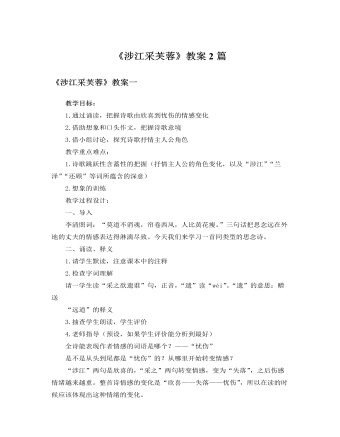
人教版高中语文必修2《涉江采芙蓉》教案2篇
三、想象画面,把握意境1.指导想象学习陶渊明的《归园田居》我们脑海中自然会出现一幅幅的画面,比如他归家后的生活场景,我们会想象“榆柳”是如何遮蔽房屋的,而“桃李”又是如何摘种在房前的。我们会想象村落是如何在薄雾中若隐若现的,想象炊烟是如何袅袅升起的。《涉江采芙蓉》一诗只有8句话,更需要我们展开想象,去构画场景,这样才能深入诗歌,体会到诗歌的味道。2.学生想象要求学生闭目想象1分钟。3.学生展示想象结果(抽三四个学生回答即可)4.老师指导纠正学生想象不合理之处。要注意的地方:“江”可能学生会想象成小溪流、小池塘。“兰泽”可能学生理解成“湖泊”。注意字词“还顾”“漫浩浩”中隐含的情感,注意“离居”中流露的愁怨。5.时间允许的话,老师读自己的下水作文。

人教版高中语文必修2《短歌行》教案2篇
教学过程:一、导语毛泽东在《沁园春雪》俯视封建君王“惜秦皇汉武。。。只识弯弓射大雕。”但如果历史上只有一个人可以与他相提并论,这个人只能是魏武帝曹操。“滚滚长江东逝水,浪花淘尽英雄。是非成败转头空,青山依旧在,几度夕阳红。”(《三国演义》卷首词)在历史的大浪淘沙中,有多少英雄能够经得起历史的千淘万漉而流芳百世呢?曹操应该是三国时代留下了浓重一笔的人物。老师总结,并启发他们去联系:我们学过他的《观沧海》“东临碣石,以观沧海…”还有《龟虽寿》“神龟虽寿,猷有竟时。老骥伏枥,志在千里;烈士暮年,壮心不已。”《青梅煮洒论英雄》中曾和他见过,《三国演义》电视剧播出后,大家和他也就频频见面了。《三国演义》第48回“宴长江曹操赋诗”中,赤壁之战前夕,曹操和众部将一起狂饮,他四顾空阔,心中大喜,与诸将讲述自己希望收服江南的雄心壮志。

新人教版高中英语必修2Unit 2 Wildlife Protection-Reading for Writing教案二
This lesson aims at making a poster about protecting wildlife after reading some posters. During reading students are guided to understand the content and try to summarize the posters with one sentence. Then students are guided to try to make a poster about protecting wildlife.1. Read the two posters and try to understand the summary sentences.2. Look at the two posters and try to understand what emotions they express.3. Try to summarize the features of posters4. Try to make a poster about wildlife.1. Look at the two posters and try to understand what emotions they express.2. Try to summarize the features of posters3. Try to make a poster about wildlife.Step 1 Lead inLook at the the posters on the textbook and ask:Which emotions do the posters communicate ?Step 2 Read the poster and answer the questions.1. What do you think of the animals in the poster on the left ?I think it is frightening and ugly.2. Why do we should protect the ugly animals ?All species--the good, the bad, and the ugly-- should be treated equally.The world needs all kinds--without variety, our planet cannot survive.3. Why are billions of trees being cut down every year ?To make paper for humans.4. What result will be lead to after the trees are cut down ?A lost of animal homes are being destroyed./The habitat of wildlife is being destroyed.Step 3 Find the feature of posters1. What does each poster use to stir up emotions ?On the left, it makes us a little frightened and it looks a little ugly, but it can activate our curiosity--What is it? And What is wrong with it?On the right, it makes us feel a little sad and want to protect them.

新人教版高中英语必修2Unit 2 Wildlife Protection-Discovering Useful Structure教案二
2.表示现阶段正在进行的被动动作(该动作在说话的瞬间未必正在进行)。Many interesting experiments are being carried out these days.(说话时,并不一定正在进行)3.表示一种经常性的被动行为,常和always,constantly 等表示频度的副词连用,这种用法常常带有赞扬或厌恶的感情色彩。He is always being praised by the leader.4.表示按计划或安排主语将要承受谓语动词所表示的动作(仅限于少数及物动词)。A party is being held tonight.Step 4 Special cases1.像take care of, look after, talk about, think of等动词与介词构成的短语用于现在进行时的被动语态时, 其中的介词不可省略。The ways to stop illegally hunting are being talked about. 2.可与部分情态动词连用,表示对正在发生的事情的推测。She may be being punished by her mother.3.有时可表示按计划或安排将要进行的一个被动动作。A celebration is being held this weekend for his success.4.某些表示“状态、心理活动、存在”等的动词,如have,want,need,love,一般不用现在进行时的被动语态,而常用一般现在时的被动语态。With the population increasing,more land is needed.5.“be+under/in+n.”可表示现在进行时的被动意义。My computer is under repair.=My computer is being repaired.

新人教版高中英语必修2Unit 2 Wildlife Protection-Discovering Useful Structure教案一
The activity topic of this section is "report an ongoing event", and the structure is the passive voice of present continuous tense. Rare wild animals are suffering from large-scale poaching, and species are on the brink of danger. Rescue operations are underway. "Being" and "suffering" are the meanings of the present progressive passive voice.The usage of present progressive passive voice is of great importance in writing a good discourse and appreciating some difficult language items, so it is vital to master it and use it flexibly in a context.1. Motivate Ss to deepen the understanding of the usage of present progressive passive voice in a fixed context.2. Enable Ss to master the usage of present progressive passive voice and use it flexibly in a context.3. Lead Ss to construct sentences or appreciate sentences used master it and use it flexibly in a context.1. Help students to appreciate the function of the usage of present progressive passive voice in a sentence2. Instruct students to write essays using the proper usage of present progressive passive voice.Look at the picture and tell me what are workers doing? What is the house being done?

新人教版高中英语必修2Unit 2 Wildlife Protection-Listening &Speaking&Talking教案
Listening and Speaking introduces the topic of “how to save endangered wildlife and help wildlife in their neighborhood.” Due to the continuous deterioration of the living environment, a large number of wild animals are always facing the threat of endangered or extinction. Listening and speaking period enables students to understand the fact and reason why wild species are disappearing from the earth at an amazing speed, and realize that human beings ought to enhance the awareness of protecting wild species as soon as possible.Listening and Talking introduces the theme of " how to help wildlife in Ss’ neighborhood.". Now there are many volunteers who spontaneously protect wild animals, carry out various activities according to local conditions, and contribute their own strength to local animal protection with practical actions. Middle school students are also enthusiastic participants. They organize activities in their spare time, and take this opportunity to make friends, broaden their horizons, cultivate team spirit and communication skills. This section describes a bird watching activity organized by several middle school students of Bird watching Club. It aims to stimulate students' interest, improve their understanding of bird watching activities, and use the language structure of “being used for; in order to, so as to, to, so that, in order that ” to express the purpose for communication and discussion.1. Guide students to understand the content of listening texts in terms of using visuals to predict content.2. Cultivate students' ability to guess the meaning of words in listening; discuss with their peers how to save endangered wildlife and help wildlife in their neighborhood.3. Instruct students to use functional sentences of the dialogue such as “I am concerned about…” “what do you know about the endangered animals in…" and so on to talk about one of the endangered animals.

新人教版高中英语必修2Unit 2 Wildlife Protection-Reading and Thinking教案二
The theme of this unit is human and nature, focusing on the theme of wildlife protection. Nature is a complex ecosystem, in which there are delicate balance between animals and plants. Because of the role of the food chain, the extinction of one species will produce influence, causing a series of chain reaction. Large scale extinction of species will have a serious and even irreversible impact on the ecosystem, resulting in immeasurable losses. Therefore, it is of great significance to protect wild species. To protect wild species is to protect human beings themselves. The motto of this unit is "when the buying stops, the killing can too,” which is a public service advertising slogan to protect wildlife. It tells people that every rhinoceros horn, every fur, every bowl of shark fin soup, every Ivory product, and every tiger bone product, etc. consumed by human beings, are innocent wild animals slaughtered behind them. The mission of wild aid is to ban illegal trade in endangered wildlife and mitigate climate change. It aims to educate the public to reduce the consumption demand for endangered wildlife products through public publicity and improve the awareness of environmental protection.1. Improve the awareness of wildlife protection by acquiring the knowledge of wildlife protection.2. Focus on environmental protection and protection of all lives.3. Analysis of the living environment of wild animals with appropriate thinking mode.4. Skillfully use the vocabulary and grammar knowledge of this unit to cultivate self-study ability according to the unit content5. Develop cooperative learning ability through discussion and other ways1. Enable the Ss to talk about the current situation of wild animals.2. Guide the Ss to summarize the main idea of each paragraph as well as the main idea of the text.

新人教版高中英语必修2Unit 2 Wildlife Protection-Reading For Writing教案一
1. 标题首先根据海报的特点、格式写明标题。海报中往往把内容作为大标题。例如: Save the earth, Save the birds。2. 正文部分不同的海报其正文部分的侧重点不同。对于介绍性的海报, 首先要引出话题, 其次列出原因, 最后是总结。对于宣传类的海报, 要写明具体内容, 如: 活动内容, 地点以及参加活动的注意事项, 主持或举办单位等。1. 图片: 要选择引人注目的图片, 与主题要相关, 色彩明亮。话题句式 1. It is a treasure of our country. 它是我国的国宝。2. Believe it or not, at present only several thousand pandas exist in the world. 信不信由你, 目前世界上仅现存几千只熊猫。 3.It’s because of human activities that tigers are endangered. 正是因为人类的活动, 老虎处于濒危的状态。4. Many wild animals are in danger of dying out. 很多野生动物面临着灭绝的危险。 5. The government has taken effective measures to protect them. 政府已采取有效的措施来保护它们。6. People should raise the awareness of the protection of wild animals. 人们应该提高保护野生动物的意识。 7. It’s amazing that there are merely less than 1, 000 finless porpoises living in China. 非常令人吃惊, 目前中国仅有不足1 000只江豚。
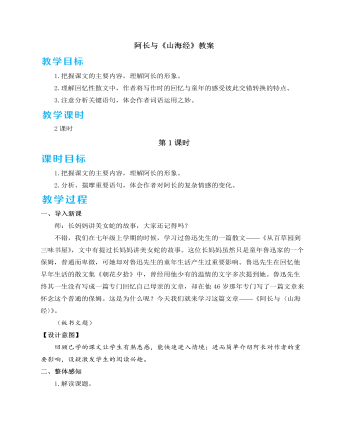
人教部编版七年级下册阿长与《山海经》教案
四、总结存储1.教师总结。纵观作者对阿长形象的刻画,犹如一部连续剧。从“喜欢切切察察”,对“我”过分看管,到睡相粗俗;从“懂得许多规矩”,特别是“元旦的古怪仪式”,到给“我”讲长毛的故事,再到“谋害”隐鼠,多侧面多角度地展现出阿长的个性特点:粗俗好事,迷信无知,却又乐天安命,简单率性。直到阿长给“我”买来《山海经》,先抑后扬的表达效果才充分显现,阿长纯朴善良、仁厚慈爱的品格在前文的衬托下显得格外闪光。而文章末尾,作者饱含深情地祝祷,将全文情感推向高潮。2.课外练笔。在你的童年生活中,有没有像阿长这样给你留下深刻印象的普通人?你怎样看待他们的优缺点?谈一谈你的想法和感受。(200字左右)【设计意图】在学生对课文有了整体的认知之后,教师总结提升。然后要求学生发现生活中普通人的闪光点,发现人性美,并进行课外练笔,有利于学生在实践中巩固技能,以读促写,读写结合,不仅可以加深对课文内容的理解,还能锻炼学生的写作能力。
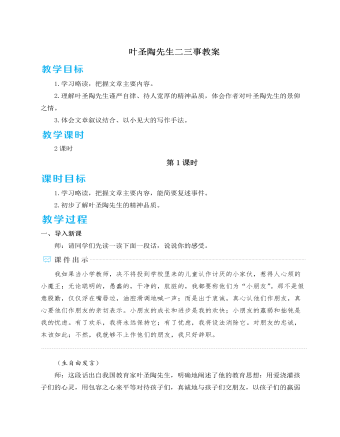
人教部编版七年级下册叶圣陶先生二三事教案
我认识圣陶先生是在成都,1941年春天的一个细雨蒙蒙的上午。那时候我在华西大学中国文化研究所工作,圣陶先生在四川省教育科学馆工作。教育科学馆计划出一套供中学语文教师用的参考书。其中有一本《精读指导举隅》和一本《略读指导举隅》,是由圣陶先生和朱佩弦先生合作编写的。计划里边还有一本讲文法的书,圣陶先生从顾颉刚先生那里知道我曾经在云南大学教过这门课,就来征求我的意见,能否答应写这样一本书。我第一次见到圣陶先生,跟我想象中的“文学家”的形象全不一样:一件旧棉袍,一把油纸雨伞,说话慢言细语,像一位老塾师。他说明来意之后,我答应试试看。又随便谈了几句关于语文教学的话,他就回去了。那时候圣陶先生从乐山搬来成都不久,住家和办公都在郊外。过了几天,他让人送来一套正中书局的国文课本,供我写书取用例句。
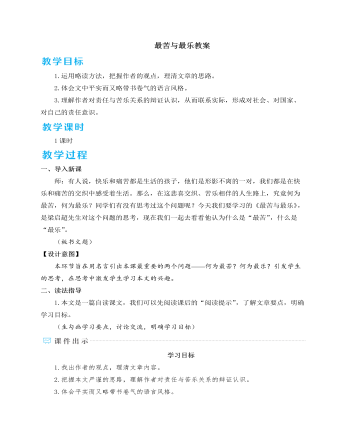
人教部编版七年级下册最苦与最乐教案
梁启超(1873—1929),字卓如,号任公,别号饮冰室主人。广东新会人,思想家、学者。清朝光绪年间举人,戊戌变法(百日维新)领袖之一、中国近代维新派、新法家代表人物。幼年受传统教育,光绪十年(1884)中秀才,1889年中举。后从师于康有为,成为资产阶级改良派的宣传家。维新变法前,协助康有为一起联合在京应试举人发动“公车上书”运动,此后先后领导北京和上海的强学会,又与黄遵宪一起办《时务报》,任长沙时务学堂的总教习,并著《变法通议》为变法做宣传。戊戌变法失败后,逃亡日本。晚年任清华国学研究院导师。他一生著述颇丰,著有《清代学术概论》《中国近三百年学术史》等,著作大多收入《饮冰室合集》。文学知识议论文议论文是一种以议论为主要表达方式,通过摆事实、讲道理,直接表达作者的观点和主张的常用文体。论点、论据和论证,是议论文的三要素。
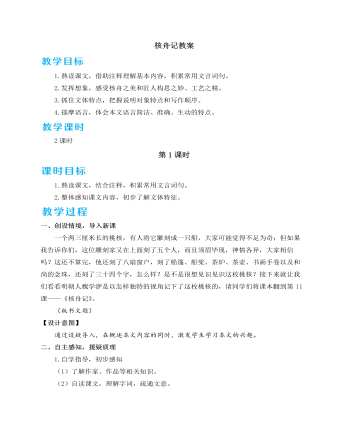
人教部编版语文八年级下册核舟记教案
《核舟记》是一篇说明性质的文言文,作者在完整而深刻地理解雕刻艺术构思的基础上,合理安排材料,运用简练生动的文字再现了“核舟”的形象。本课教学设计,注重学生自主学习、自主探究、自主拓展,教师予以有效指导。教学中的各个环节环环相扣,思路清晰。在自主学习的过程中,掌握文章的基本内容;在合作学习的过程中,完成文言知识卡片的归纳整理;在探究学习的过程中,通过“找一找”“品一品”两个环节,让学生深入到文本中进行赏析,感知核舟的奇巧,感悟雕刻者技艺的精巧和构思的精妙,学习作者行文的巧妙,体会到文章语言的简洁、准确和生动;在布置作业环节,联系课堂内外,有拓展延伸的阅读,有学以致用的练笔。整个教学设计适应了学生各种能力的发展需要,提高了学生的语文素养。疑难探究《核舟记》一般被视为说明文,但文中包含了大量的描写。对此应该如何理解?首先,说明文是今天我们按照记叙文、说明文、议论文三大文体分类为之做出的界定,而古人的文体分类中并无“说明文”一类,《核舟记》这种记物之文和记游、记亭台楼阁之文都属于“杂记”。
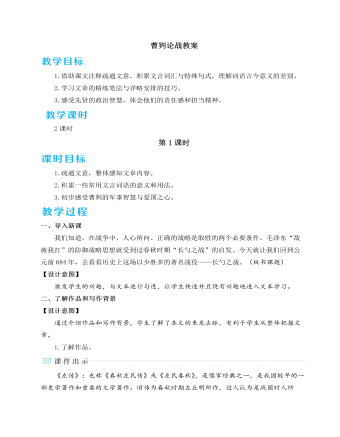
人教部编版语文九年级下册曹刿论战教案
开门见山,免去了君臣相见的繁文缛节的叙述;“齐人三鼓”一句,就包括了齐军的第一次和第二次击鼓进击而鲁军未出击的过程,也写出了齐军依仗数量上的优势企图取胜的急切心理;两个“可矣”写出了鲁军进军的情况;“辙乱”“旗靡”四个字就概括了齐军溃败的具体情况。文章抛开残酷的战争场面,无一字描写,仅一个“齐师败绩”写明战争结果。多四字句,如“曹刿请见”“牺牲玉帛”“一鼓作气”等,读来典雅端庄,辞约而意丰,言简而意明。疑难探究1.如何理解曹刿以平民身份而主动“论战”的行为?曹刿堪称中国古代平民政治家与军事家。他只是鲁国的一介平民,并非“肉食者”,本无机会参与国家大事的商讨和实施。但他凭借着一颗赤诚的爱国之心,积极参与抵御外敌入侵的政治谋划与军事行动,并创造了以弱胜强的战争奇迹。2.请试着从曹刿、鲁庄公、战争这三个角度分别用四个字对文章每一段内容进行概括。从曹刿的角度可以概括为:曹刿论战—曹刿参战—曹刿释疑。从鲁庄公的角度可以概括为:庄公将战—庄公实战—庄公问因。从战争的角度可以概括为:战前准备—战争过程—战胜原因。
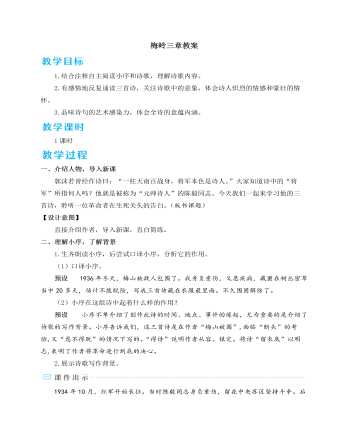
人教部编版语文九年级下册梅岭三章教案
(1)看题目。题目中蕴含着诸多信息,如时间、地点、人物、事件以及诗人的心情、诗歌的意境、诗歌的类型等。抓住这一切入点,有助于我们理解诗歌的思想感情。(2)看作者。作品是作者思想情感的具体化,所以,要准确理解诗词,把握作品的思想感情,就不能脱离作者孤立地臆断。作者的生平、写作风格、思想等等,无不影响着作者的情绪,所以,在鉴赏作品时,首先要了解作者的相关背景等。(3)看时代。把握时代风貌特征,把诗歌放在时代背景下评析,才能准确领悟其蕴含的思想感情。(4)看意象。诗歌的创作讲究含蓄、凝练。诗人的抒情往往不是情感的直接流露,而是注重弦外之音、言外之意。写景则借景抒情,咏物则托物言志。因此意象也就是作者的主观感情与客观物象的完美结合,是诗人情感显现的载体。把握诗中的意象,就能参悟意境,理解诗中蕴含的情感。
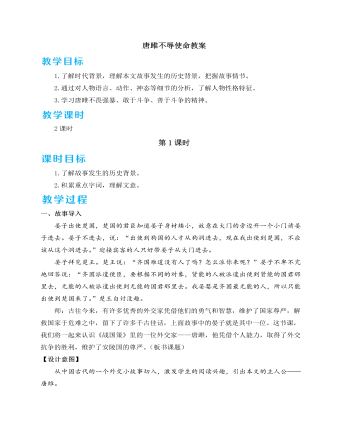
人教部编版语文九年级下册唐雎不辱使命教案
预设 对比与映衬、渲染与烘托。由于文章始终是在人物对话中展开的,人物语言和行为遵循“刺激—反应”模式平行而下,自然形成了对比,造成了映衬互见的效果。如围绕易地问题,就有秦王的欲求与安陵君的坚守,有秦王的无理狡辩与唐雎的据理抗争;在意志较量方面,则有“天子之怒”与“布衣之怒”的对垒。秦王所说的“天子之怒”,唐雎的“未尝闻”;唐雎所说的“布衣之怒”,秦王归之于“免冠徒跣,以头抢地”。一个拒绝回答,非常傲气;一个丑化描述,极为轻蔑。这样,人物形象对比鲜明,相互衬托,将一场正义与非正义的较量真实而生动地展现出来。作者为了追求夸张、强化的效果,多借助人物语言渲染气势、烘托气氛,增强故事的“现场感”。如秦王说“灭韩亡魏”,目的是从气势上压倒对手;唐雎罗列刺客的壮举,也表明了血拼到底的气概。秦王先说“灭韩亡魏”,气势夺人;后说“韩、魏灭亡”,辞格已卑。这些生动的描写,极大地凸显了人物性格。
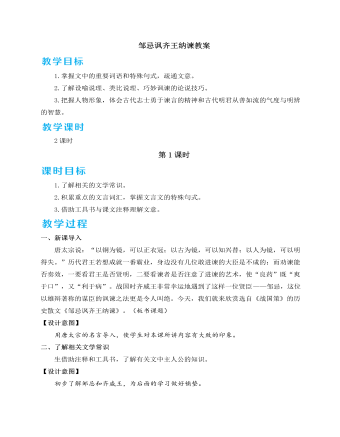
人教部编版语文九年级下册邹忌讽齐王纳谏教案
第二,《战国策》描写人物的性格和活动更加具体细致,也就更显得生动活泼。《左传》描写人物,大抵是简笔勾勒。第三,《战国策》所记的策士说辞,常常引用生动的寓言故事,这也是以文学手段帮助说理的方法。这些寓言,形象鲜明,寓意深刻,又浅显易懂,独立地看也是中国文学宝库中的璀璨明珠。疑难探究除了高超的语言艺术,邹忌劝谏成功还有哪些重要因素?除了高超的语言艺术,邹忌能劝谏成功,还有其他重要的因素。比如:这也与邹忌善于思考、分析的个性和他的担当、责任意识相关。邹忌关心国家大事,一心想寻找恰当时机劝谏齐王。他在生活中经历了“比美”经历,能够深入思考、分析,体察各人的情状心理,并敏锐地由个人体验联系到国家大事,想到齐王所受之蔽,于是果断地进行劝谏。这也离不开齐王广开言路的胸襟和果断行事的理政智慧。齐王听了邹忌的劝谏,马上“下令”,并且分上、中、下三种不同层面赏赐,立刻实施,表现出一位贤明君主的特点。
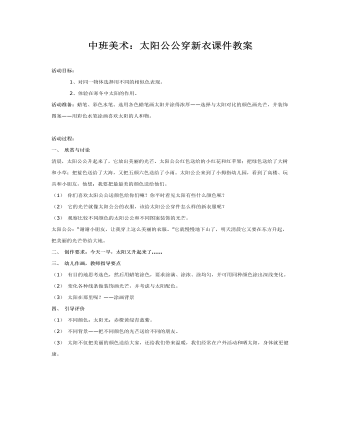
中班美术:太阳公公穿新衣课件教案
2、体验在寒冬中太阳的作用。活动准备:蜡笔、彩色水笔。选用各色蜡笔画太阳并涂得浓厚——选择与太阳对比的颜色画光芒,并装饰图案——用彩色水笔涂画喜欢太阳的人和物。 活动过程:一、欣赏与讨论清晨,太阳公公升起来了,它放出美丽的光芒。太阳公公红色送给的小红花和红苹果;把绿色送给了大树和小草;把蓝色送给了大海,又把五颜六色送给了小雨。太阳公公来到了小拇指幼儿园,看到了高楼、玩具和小朋友,他想:我要把最最美的颜色送给他们。(1)你们喜欢太阳公公送颜色给你们嘛?你平时看见太阳有些什么颜色呢?(2)它的光芒就像太阳公公的衣服,该给太阳公公穿件怎么样的新衣服呢?(3)观察比较不同颜色的太阳公公和不同图案装饰的光芒。太阳公公:“谢谢小朋友,让我穿上这么美丽的衣服。”它就慢慢地下山了,明天清晨它又要在东方升起,把美丽的光芒带给大地。









